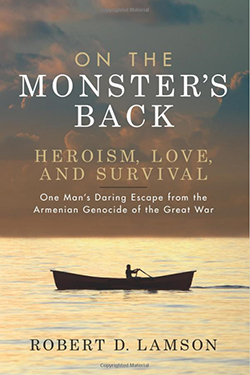Class News
Bob Lamson '64 — His book reviewed by The Huffington Post
On The Monster’s Back: Heroism, Love and Survival
On the Monster’s Back remembers how one Armenian survived genocide

Book review by Stanley Weiss
Huffington Post
July 27, 2015
LONDON — The story has been told so often it is surprising that more people aren’t familiar with it, or that it doesn’t weigh more heavily upon us. Reputedly, when Hitler decided to go forward with the Holocaust, he was warned that history would not forget or forgive him. His response? “Who remembers the Armenians?”
This year marks the 100-year anniversary of the Armenian genocide, regarded by the heirs of its victims to be the first attempt by a modern government to wipe out an entire racial, religious, or cultural group. In On The Monster’s Back: Heroism, Love and Survival, Robert D. Lamson reminds readers of the forced removal during World War I that took the lives of upwards of one million Armenians (Greek and Assyrian populations, also targeted, suffered in similar magnitudes) in what was first the Ottoman Empire and then Turkey. He tells the story of how one young man survived.
That young man, Souren Tashjian, was a teenager at the outbreak of the war, living in the Anatolian port metropolis of Smyrna. At the time a cosmopolitan city, Smyrna was made up of large numbers of Greeks and Jews, as well as Turks and Armenians. As a cultural and economic centre, it drew business travelers and missionaries from throughout Europe and North America, particularly Germany, the United Kingdom, and the United States.
The Smyrna of Souren’s childhood had enjoyed relative multicultural tolerance although, as with much of the Ottoman domain, its past included considerable persecution of minorities and some day-to-day discrimination and harassment persisted. Souren’s older siblings had all been sent to America in pursuit of opportunity and freedom from the tensions and anxieties that Armenians and other non-Turks felt about life under Ottoman rule, But with their youngest son just entering his adolescence, his parents stayed back, cherishing the hope that the treatment of their people would improve.
Virtually all genocide accounts leave readers asking the same heartbreaking question: Why didn’t they flee when they had the chance? Usually the asking is in essence rhetorical, recognizing that the hardships of abandoning home and heritage, with children in tow and little or no money to see a family through, often made hoping for the best a necessary default rather than a living choice.
The family’s plan for Souren, even in childhood, was to have him follow his older siblings to America and to medical school, when he came of age. But as war clouds gathered, his parents lacked funds to accelerate the departure. Meanwhile, prompted by the apparent liberalism of the Young Turks who had ousted the old Ottoman guard, the years immediately before the war became a time of hope for many among the empire’s minorities, even as others warned that the changes were cosmetic. For within the Armenian, Greek, and Jewish communities a vigorous debate raged over the nature of the Young Turks, and whether the new regime would truly pursue promised policies of greater tolerance. Lamson makes his readers witness to these discussions, reminiscent in many ways of debates in our own time over whether various oppressive or warlike regimes are ‘liberalizing’ and becoming more ‘open.’
In the event, the Armenian hopes were dashed as those who feared the worst were proven right. When the Great War came, the Young Turks ratcheted up the level of persecution against minorities.
Again and again Lamson reminds us how near-run a thing survival is in such a land, and how often escape depends on luck and luck alone. In episode after episode, the reader is held in suspense as Souren narrowly eludes capture by one group of Ottoman authorities or another. His survival turns on fortuitous breaks — be they inept soldiers who didn’t bother to look more searchingly, or police officers amenable to bribes, or access to a military uniform, or the opportunity to win the favor of a German military officer. It is easy to see how things could have gone differently for the boy, who might well have ended his days at the end of a Turkish rope. Instead he lived another 60 years, becoming — as he had dreamed — a doctor, ultimately in Seattle.
Lamson’s story of the young boy, who was an old man when Lamson knew him, reminds us how difficult and often unlikely it is to survive when the will to kill is everywhere. Lamson makes clear that the question to ask isn’t “Why didn’t they get out?” Rather, for those who remember the Armenians and other victims of the era, we should ponder how much more monstrous the horror would have been had there existed no land of justice across the sea in which so many could find refuge in a new life that was free.

Robert D. Lamson is an author and senior business counselor. A former defense economist and now semi-retired businessman, he holds a BA in economics from Yale University and a PhD in economics from the University of Washington.
He has cofounded and led several successful businesses, and most recently is founder of Historical Accounts Repository Partners (HARP), a 501(c)(3) educational foundation. HARP is dedicated to bringing to light previously unexposed historical material, emphasizing heroic personal acounts such as the subject of this book.
His previous book is a work on military spending and the economy, Beyond Guns and Butter, coauthored with Glenn Pascall.
One quarter Armenian via his paternal grandmother, he and his wife of 50 years live in Seattle. Together they have two daughters and five grandchildren.

